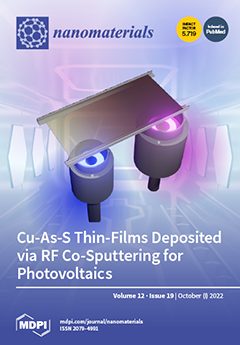Significant agricultural and industrial activities necessitate the regular monitoring of nitrate (NO
3−) ions levels in feed and groundwater. The current comparative study discloses an innovative user-friendly electrochemical approach for the determination of NO
3− over polyaniline (PAni)-based modified electrodes.
[...] Read more.
Significant agricultural and industrial activities necessitate the regular monitoring of nitrate (NO
3−) ions levels in feed and groundwater. The current comparative study discloses an innovative user-friendly electrochemical approach for the determination of NO
3− over polyaniline (PAni)-based modified electrodes. The electrochemical sensors concocted with PAni, multi-walled carbon nanotubes (CNT), and gum arabic (GA). The unique electrode material GA@PAni-CNT was synthesized by facile one-pot catalytic polymerization of aniline (Ani) with FeCl
3/H
2O
2 in the presence of CNT and GA as integral components. As revealed by cyclic voltammetry (CV), the anchoring/retention of NO
3− followed by reduction is proposed to occur when a GA@PAni-CNT electrode is immersed in phosphate buffer electrolyte containing NO
3− that eventually results in a significantly higher redox activity of the GA@PAni-CNT electrode upon potential scan. The mechanism of NO
3− anchoring may be associated with the non-redox transition of leucomeraldine salt (LS) into emeraldine salt (ES) and the generation of nitrite (NO
2−) ions. As a result, the oxidation current produced by CV for redox transition of ES ↔ pernigraniline (PN) was ~9 times of that obtained with GA@PAni-CNT electrode and phosphate buffer electrolyte, thus achieving indirect NO
3− voltammetric determination of the GA@PAni-CNT electrode. The prepared GA@PAni-CNT electrode displayed a higher charge transfer ability as compared to that of PAni-CNT and PAni electrodes. The optimum square wave voltammetric (SWV) response resulted in two linear concentration ranges of 1–10 (R
2 = 0.9995) and 15–50 µM (R
2 = 0.9988) with a detection limit of 0.42 µM, which is significantly lower. The GA@PAni-CNT electrode demonstrated the best detection, sensitivity, and performance among the investigated electrodes for indirect voltammetric determination of NO
3− that portrayed the possibility of utilizing GA—stabilized PAni and CNT nanocomposite materials in additional electrochemical sensing applications.
Full article






